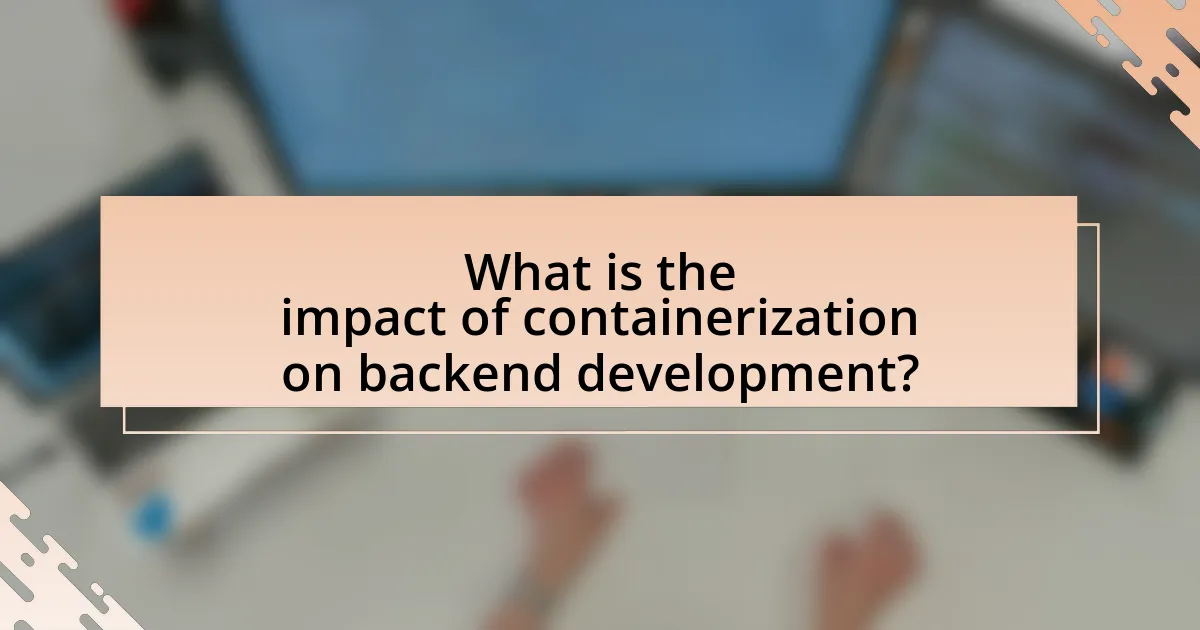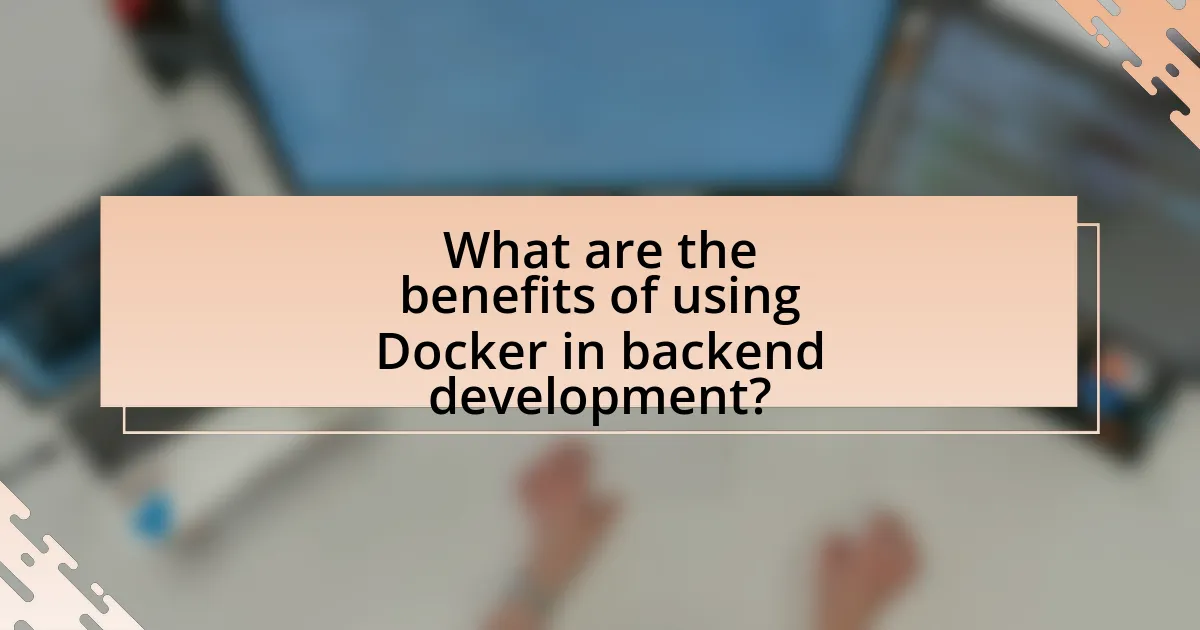The article examines the impact of containerization on backend development, focusing on the roles of Docker and Kubernetes. It highlights how containerization enhances application consistency, reduces deployment issues, and improves resource utilization, leading to increased productivity and operational efficiency. Key features such as isolation, portability, scalability, and resource efficiency are discussed, along with the benefits of using Docker for local development and collaboration among teams. Additionally, the article addresses the complexities and challenges associated with Kubernetes, offering best practices for implementation and strategies to ensure security and performance in containerized backend systems.
What is the impact of containerization on backend development?

Containerization significantly enhances backend development by providing a consistent environment for applications, which reduces deployment issues. This technology allows developers to package applications and their dependencies into containers, ensuring that they run uniformly across different computing environments. For instance, Docker, a leading containerization platform, enables rapid deployment and scaling of applications, which can lead to increased productivity and reduced time-to-market. Additionally, Kubernetes, an orchestration tool for managing containerized applications, facilitates automated deployment, scaling, and management, further streamlining backend processes. The adoption of these technologies has been shown to improve resource utilization and operational efficiency, as evidenced by a 2019 report from the Cloud Native Computing Foundation, which indicated that organizations using Kubernetes experienced a 50% reduction in infrastructure costs.
How has containerization changed the landscape of backend development?
Containerization has fundamentally transformed backend development by enabling consistent environments across various stages of the software lifecycle. This technology allows developers to package applications and their dependencies into containers, ensuring that they run uniformly regardless of the underlying infrastructure. For instance, Docker, a leading containerization platform, simplifies the deployment process, reduces conflicts between development and production environments, and enhances scalability. According to a 2021 survey by the Cloud Native Computing Foundation, 96% of organizations reported using containers in production, highlighting their widespread adoption and the shift towards microservices architecture. This shift has led to improved resource utilization, faster deployment times, and greater flexibility in managing application updates and rollbacks.
What are the key features of containerization that influence backend development?
The key features of containerization that influence backend development include isolation, portability, scalability, and resource efficiency. Isolation allows developers to run applications in separate environments, minimizing conflicts and dependencies, which enhances stability and security. Portability enables applications to run consistently across different environments, such as development, testing, and production, facilitating smoother deployment processes. Scalability allows backend systems to efficiently manage increased loads by easily adding or removing container instances, which is crucial for handling varying traffic demands. Resource efficiency optimizes the use of system resources, as containers share the host OS kernel, leading to faster startup times and reduced overhead compared to traditional virtual machines. These features collectively streamline the development and deployment processes, making backend systems more agile and responsive to changing requirements.
How does containerization improve deployment processes in backend development?
Containerization improves deployment processes in backend development by enabling consistent environments across different stages of development and production. This consistency reduces the “it works on my machine” problem, as applications run in the same container regardless of where they are deployed. Additionally, containerization allows for faster deployment times due to the lightweight nature of containers, which can be spun up or down quickly. According to a study by the Cloud Native Computing Foundation, organizations using container orchestration tools like Kubernetes report a 50% reduction in deployment times, demonstrating the efficiency gains containerization provides.
Why are Docker and Kubernetes significant in backend development?
Docker and Kubernetes are significant in backend development because they enable efficient application deployment, scaling, and management through containerization. Docker allows developers to package applications and their dependencies into containers, ensuring consistency across different environments. Kubernetes orchestrates these containers, automating deployment, scaling, and operations, which enhances resource utilization and reduces downtime. According to a 2021 survey by the Cloud Native Computing Foundation, 96% of organizations reported using Kubernetes, highlighting its widespread adoption and importance in modern backend architectures.
What roles do Docker and Kubernetes play in containerization?
Docker is a platform that enables developers to create, deploy, and manage containers, while Kubernetes is an orchestration tool that automates the deployment, scaling, and management of those containers. Docker simplifies the process of packaging applications and their dependencies into containers, ensuring consistency across different environments. Kubernetes enhances this by providing a robust framework for managing containerized applications at scale, allowing for automated load balancing, self-healing, and rolling updates. Together, Docker and Kubernetes streamline the development and operational processes in containerization, making it easier to build and maintain applications in a microservices architecture.
How do Docker and Kubernetes enhance scalability and management in backend systems?
Docker and Kubernetes enhance scalability and management in backend systems by enabling efficient resource utilization and automated orchestration of containerized applications. Docker allows developers to package applications and their dependencies into containers, ensuring consistency across different environments and facilitating rapid deployment. Kubernetes, on the other hand, automates the deployment, scaling, and management of these containers, allowing for dynamic scaling based on demand. For instance, Kubernetes can automatically adjust the number of running container instances in response to traffic fluctuations, ensuring optimal performance and resource allocation. This combination of Docker’s containerization and Kubernetes’ orchestration capabilities leads to improved operational efficiency and reduced downtime, ultimately enhancing the scalability and management of backend systems.
What are the benefits of using Docker in backend development?

Using Docker in backend development offers significant benefits, including environment consistency, scalability, and efficient resource utilization. Docker ensures that applications run the same way in development, testing, and production environments by packaging them with all dependencies, which reduces the “it works on my machine” problem. This consistency leads to fewer bugs and faster deployment times. Additionally, Docker allows developers to easily scale applications by deploying multiple containers, which can be managed and orchestrated efficiently. Furthermore, Docker optimizes resource usage by enabling multiple containers to run on a single host without the overhead of traditional virtual machines, leading to cost savings and improved performance. These advantages make Docker a powerful tool in modern backend development.
How does Docker streamline the development workflow?
Docker streamlines the development workflow by enabling consistent environments across different stages of development, testing, and production. This consistency reduces the “it works on my machine” problem, as developers can create containers that encapsulate all dependencies and configurations needed for their applications. Furthermore, Docker’s lightweight containers allow for rapid deployment and scaling, facilitating continuous integration and continuous deployment (CI/CD) practices. According to a survey by the Cloud Native Computing Foundation, 78% of developers reported increased productivity when using containerization tools like Docker, highlighting its effectiveness in enhancing workflow efficiency.
What are the advantages of using Docker for local development environments?
Using Docker for local development environments offers several advantages, including consistency, isolation, and efficiency. Consistency is achieved because Docker containers encapsulate all dependencies and configurations, ensuring that applications run the same way across different environments. Isolation allows developers to run multiple applications with conflicting dependencies on the same machine without interference. Efficiency is enhanced through faster setup and teardown of environments, as containers can be quickly created and destroyed compared to traditional virtual machines. These benefits lead to improved productivity and reduced “it works on my machine” issues, making Docker a valuable tool for developers.
How does Docker facilitate collaboration among development teams?
Docker facilitates collaboration among development teams by providing a consistent environment for application development and deployment. This consistency allows team members to work on the same codebase without worrying about discrepancies in their local setups, as Docker containers encapsulate all dependencies and configurations needed to run an application. Furthermore, Docker’s version control features enable teams to track changes in container images, ensuring that everyone is using the same version of the application. This reduces the “it works on my machine” problem, streamlining the development process and enhancing productivity.
What challenges can arise when using Docker in backend development?
Challenges that can arise when using Docker in backend development include complexity in configuration, performance overhead, and networking issues. The complexity of managing Docker containers can lead to misconfigurations, which may result in application failures or security vulnerabilities. Performance overhead occurs due to the additional layer of abstraction that containers introduce, potentially affecting application speed and resource utilization. Networking issues can arise from the need to manage container communication, which may complicate service discovery and load balancing. These challenges highlight the need for careful planning and expertise in Docker management to ensure effective backend development.
What are common pitfalls developers face with Docker?
Common pitfalls developers face with Docker include improper image management, which can lead to bloated images and increased build times. Developers often neglect to optimize Dockerfiles, resulting in larger-than-necessary images that slow down deployment and consume more resources. Additionally, misconfiguring networking settings can cause connectivity issues between containers, complicating communication in multi-container applications. Another frequent mistake is failing to manage container lifecycle properly, leading to orphaned containers that consume system resources. Security vulnerabilities also arise when developers overlook best practices for image security, such as using outdated base images or not scanning for vulnerabilities. These pitfalls can significantly impact the efficiency and security of applications deployed using Docker.
How can these challenges be mitigated in a development environment?
To mitigate challenges in a development environment related to containerization, teams can implement best practices such as adopting standardized container images, utilizing orchestration tools like Kubernetes for automated deployment, and establishing robust monitoring and logging systems. Standardized container images reduce inconsistencies across environments, ensuring that applications run smoothly regardless of where they are deployed. Kubernetes facilitates scaling and management of containerized applications, addressing issues like resource allocation and service discovery. Additionally, effective monitoring and logging provide insights into application performance and help identify issues early, allowing for quicker resolution and improved stability.
What advantages does Kubernetes offer for backend development?

Kubernetes offers several advantages for backend development, including automated deployment, scaling, and management of containerized applications. This orchestration platform enables developers to efficiently manage microservices architectures, ensuring high availability and fault tolerance. Kubernetes also supports rolling updates and rollbacks, allowing for seamless application updates without downtime. Additionally, its built-in service discovery and load balancing features enhance application performance and reliability. According to the Cloud Native Computing Foundation, Kubernetes has become the de facto standard for container orchestration, demonstrating its widespread adoption and effectiveness in streamlining backend development processes.
How does Kubernetes manage container orchestration effectively?
Kubernetes manages container orchestration effectively by automating the deployment, scaling, and operation of application containers across clusters of hosts. It achieves this through a declarative configuration model, allowing users to define the desired state of their applications, which Kubernetes then maintains automatically. For instance, if a container fails, Kubernetes automatically restarts it, ensuring high availability. Additionally, Kubernetes employs features like load balancing, service discovery, and automated rollouts and rollbacks, which enhance the resilience and scalability of applications. These capabilities are supported by a robust ecosystem of tools and APIs, making Kubernetes a leading choice for container orchestration in modern backend development.
What are the key components of Kubernetes that support backend applications?
The key components of Kubernetes that support backend applications are Pods, Services, Deployments, and ConfigMaps. Pods are the smallest deployable units in Kubernetes, encapsulating one or more containers that run the backend application. Services provide stable networking and load balancing for Pods, ensuring that backend applications can communicate reliably. Deployments manage the lifecycle of Pods, allowing for scaling and updates without downtime, which is crucial for maintaining backend application availability. ConfigMaps store configuration data that can be easily injected into Pods, enabling backend applications to adapt to different environments without changing the code. These components work together to create a robust and scalable environment for backend applications, facilitating efficient resource management and deployment strategies.
How does Kubernetes ensure high availability and reliability for backend services?
Kubernetes ensures high availability and reliability for backend services through features like automated scaling, self-healing, and load balancing. Automated scaling allows Kubernetes to adjust the number of running instances of a service based on demand, ensuring that sufficient resources are available during peak loads. Self-healing capabilities enable Kubernetes to automatically replace failed instances, maintaining service continuity. Load balancing distributes incoming traffic across multiple instances, preventing any single instance from becoming a bottleneck. These mechanisms collectively enhance the resilience and uptime of backend services, making Kubernetes a robust platform for managing containerized applications.
What are the limitations of using Kubernetes in backend development?
Kubernetes has several limitations in backend development, including complexity, resource overhead, and a steep learning curve. The complexity arises from its extensive features and configurations, which can overwhelm developers, especially those new to container orchestration. Resource overhead is another limitation, as Kubernetes requires significant computational resources to manage its components, potentially leading to increased costs and reduced efficiency in smaller applications. Additionally, the steep learning curve can hinder rapid development, as teams may need substantial time to become proficient in using Kubernetes effectively. These factors can impede the agility and speed that backend development often requires.
What complexities can arise from Kubernetes configurations?
Kubernetes configurations can lead to complexities such as mismanagement of resources, difficulties in scaling applications, and challenges in maintaining security policies. Mismanagement occurs when resource limits and requests are not properly defined, resulting in inefficient resource utilization. Scaling applications can become complicated due to the need for precise configuration of Horizontal Pod Autoscalers and Cluster Autoscalers, which require careful monitoring and adjustment. Additionally, maintaining security policies can be complex because Kubernetes employs Role-Based Access Control (RBAC) and Network Policies that necessitate a thorough understanding of permissions and network configurations to prevent unauthorized access. These complexities highlight the need for careful planning and management in Kubernetes environments.
How can teams overcome the learning curve associated with Kubernetes?
Teams can overcome the learning curve associated with Kubernetes by implementing structured training programs and utilizing comprehensive documentation. Structured training, such as workshops and online courses, provides hands-on experience and accelerates understanding of Kubernetes concepts. Comprehensive documentation, including the official Kubernetes documentation and community resources, serves as a valuable reference for troubleshooting and best practices. According to a 2021 survey by the Cloud Native Computing Foundation, 78% of organizations reported that formal training significantly improved their teams’ proficiency in Kubernetes, highlighting the effectiveness of these approaches.
What best practices should be followed when implementing containerization in backend development?
When implementing containerization in backend development, best practices include using lightweight images, maintaining immutability, and orchestrating with tools like Kubernetes. Lightweight images reduce the size and improve the speed of deployments, which is crucial for efficient resource utilization. Maintaining immutability ensures that containers are not altered after creation, promoting consistency across environments and simplifying debugging. Orchestrating with Kubernetes allows for automated deployment, scaling, and management of containerized applications, enhancing reliability and performance. These practices lead to improved efficiency, scalability, and maintainability in backend development.
How can teams ensure security in containerized applications?
Teams can ensure security in containerized applications by implementing a multi-layered security approach that includes image scanning, runtime protection, and access controls. Image scanning involves using tools to identify vulnerabilities in container images before deployment, ensuring that only secure images are used. Runtime protection includes monitoring container behavior and enforcing security policies to detect and respond to anomalies in real-time. Access controls restrict permissions and limit user access to sensitive resources, reducing the risk of unauthorized actions. According to a report by the Cloud Native Computing Foundation, 90% of organizations that adopted container security practices saw a significant reduction in security incidents, highlighting the effectiveness of these measures.
What strategies can improve performance in containerized backend systems?
To improve performance in containerized backend systems, implementing resource optimization strategies is essential. These strategies include configuring resource limits for CPU and memory to prevent resource contention, using lightweight base images to reduce overhead, and employing orchestration tools like Kubernetes for efficient scaling and load balancing. Additionally, optimizing network configurations and utilizing service meshes can enhance communication between containers, leading to reduced latency and improved throughput. Studies have shown that organizations adopting these strategies experience significant performance gains, with some reporting up to a 30% increase in application responsiveness and resource utilization efficiency.